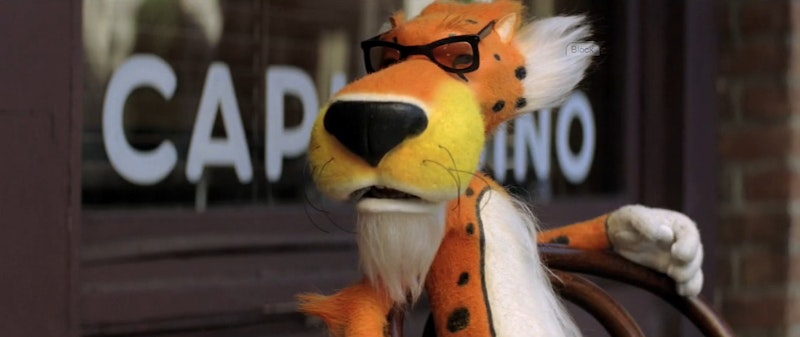Advertisers are increasingly desperate these days, but not just to sell products. They want to prove that they really, truly know you. They get you. They know that you want to lose a few pounds, prove your manhood, and enjoy Brie cheese without regret. They know exactly how you abbreviate text messages and the stream of thought in your head when you play with a smart phone. They know that you get annoyed when your wife chatters too much and that she gets annoyed when you use too many paper towels. But when did feeling become the chief catalyst for wanting to buy a product?
For example, consider the new Cheetos campaign, which aims to recruit women. Most of the television ads follow this storyline: a despicable woman is stereotypical and annoying, while a laid-back, tomboyish woman tunes her out and eats her Cheetos. Then Chester comes along, like an orange mix of Yoda and Samuel L. Jackson, and gives the girl the go ahead to exact revenge via Cheetos. Instantly, the yuppie woman whose son is becoming multi-lingual gets an orange smear on her back, and the ditz spouting “likes” gets a pigeon attack.
This ad uses stereotypes of women, but not in a simple way. Sure, the two receiving revenge are stereotypes, but the main woman, whom the ad assumes viewers will identify with, is defined only by her lack of stereotypical qualities. She isn’t a calorie counter like in the Yoplait commercials, or confined to a Weight Watchers-approved diet of soup. What bothers me is the one-dimensional examples of women that the others are exuding. In that sense, the ad steers clear of hitting women’s “ignore” radar, and the underlying message becomes, “We understand that you are unique and are sick of being labeled*. Prove it even more, by eating Cheetos.”
A Cheeto is a salty, crunchy, high-calorie snack—an indulgence. They are marked by a vivid orange color. The craving for Cheetos is arguably simple and libidinal, and happens in a part of the brain far removed from the section that contemplates issues of gender identification and self-actualization. So what makes advertisers choose to enter into a consumer’s decision-making process primarily through the forebrain? An excess of market research.
All ad campaigns need market research. Knowing what women watch and when they watch it can let the advertisers know where to place the ad. The socioeconomic traits of these future Cheetos eaters can give copywriters clues as to what level of education they have and what language they speak, and that can aid in their exact word choice. Research for ads is crucial, but the industry suffers from a neurosis of having so much information that they think they need to actually write it into the ad. As a result, target demographics acting like target demographics start popping up in television ad narratives about the lives of target demographics. Advertisers always needed to understand demographics, but they did not need to create a whole shadow literature of “the demographic.” People already don’t trust ads; seeing them desperately attempting to mimic real life is creepy.
Nonetheless, a vast majority of advertisements are now about the consumer rather than the product. Sure, extensive research about the consumer easily writes itself into a campaign, but reinvigorating the product to be interesting in and of itself takes creativity. An example of a campaign that excelled at emphasizing the product is 2006’s splash for the Sony Bravia. The Bravia is a television that boasted the standout feature of having high pixel resolution. Instead of telling a story about the customers the Bravia would please, the advertisers actually converted the idea of a plethora of pixels into a visual metaphor**: rainbow colored bouncy balls. (Sony also did the same idea with paint, colored rabbits, a thread-covered pyramid, and a city-sized game of dominos.) The association created with the product is immediately distinct and visual, animating the idea of pixels into a disjointed mess of color that comes together to make a breathtaking sight.
Of course, the Cheetos ad isn’t necessarily bad. It has the power to encourage dialogue, and is worth remembering. But take the time to imagine the Cheetos ad that could have been—what some person might have come up with if they put down the stats and focused on how Cheetos’ loud orange color and satisfying crunch could be harnessed to remind consumers of just how good that cheese-but-somehow-not-cheese powder tastes on your fingers.
Hungry yet?
*While that labeling is, in some part, the fault of advertisers’ attempts to prove they understand consumers by simplifying them into easily generalized categories and constantly depicting them as such. Ads know that this has happened, and now they want to understand us, occasionally, by un-stereotyping us.

